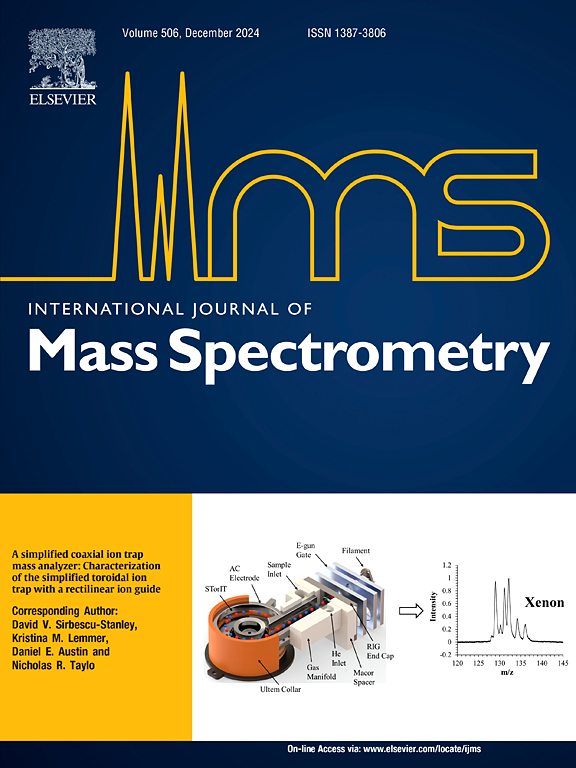Environmental photosensitizers can exhibit enhanced actinic absorption in microhydrated clusters compared to solution
IF 1.7
3区 化学
Q3 PHYSICS, ATOMIC, MOLECULAR & CHEMICAL
引用次数: 0
Abstract
Brown carbon chromophores at environmental air-water interfaces often act as photosensitizers that absorb sunlight and subsequently transfer energy to nearby molecules, initiating a wide variety of chemical reactions. Despite their importance to understanding daytime chemistry at these air-water interfaces, little is known about the role of the solvation environment on the photophysical properties of these photosensitizers. In this work, we present a joint experimental-theoretical study of the vibrational and photophysical properties of microhydrated protonated and deprotonated 4-benzoylbenzoic acid (4-BBA), a key model system for environmental photosensitizers. We find that for protonated 4-BBAH+∙(H2O)0-1, representing photosensitizers in very acidic conditions, a single bright state dominates the UV–Vis spectrum between 280 and 400 nm. Comparing the experimental UV–Vis spectra and quantum chemistry-predicted spectra of 4-BBAH+∙(H2O)0-2, we find that the degree of microhydration has little effect on the UV–Vis spectra or the orbitals of the dominant feature. For deprotonated 4-BBA‒, representing photosensitizers in basic conditions, quantum chemistry calculations predict that the UV–Vis spectra are ∼3x weaker in intensity than the brightest 4-BBAH+∙(H2O)0-1 features and were not observed experimentally. Quantum chemistry calculations predict one dominant UV–Vis feature is present in the spectra of 4-BBA‒∙(H2O)0-2, which exhibit minor shifts with degree of microhydration. While 4-BBA in bulk solution over a range of pH values has relatively weak absorption within the solar actinic region, we show that microhydrated 4-BBA has bright transitions within the actinic region. This indicates that the complex structure of environmental air-water interfaces can shift the absorption maximum of photosensitizers into the actinic region for enhanced absorption of sunlight and subsequent enhancement of photosensitizer-driven reactions.

与溶液相比,环境光敏剂在微水合簇中可以表现出增强的光化吸收
空气-水界面上的棕色碳发色团通常充当光敏剂,吸收阳光并随后将能量传递给附近的分子,引发各种各样的化学反应。尽管它们对了解这些空气-水界面的日间化学非常重要,但人们对溶剂化环境对这些光敏剂的光物理性质的作用知之甚少。本文对环境光敏剂的关键模型体系——微水合质子化和去质子化4-苯甲酰苯甲酸(4-BBA)的振动和光物理性质进行了实验-理论联合研究。我们发现,对于质子化的4-BBAH+∙(H2O)0-1,代表了非常酸性条件下的光敏剂,在280和400 nm之间的UV-Vis光谱中,单一亮态占主导地位。将4-BBAH+∙(H2O)0-2的实验紫外可见光谱与量子化学预测光谱进行比较,发现微水化程度对紫外可见光谱及主导特征的轨道影响不大。对于在基本条件下代表光敏剂的去质子化4-BBA -,量子化学计算预测紫外-可见光谱的强度比最亮的4-BBAH+∙(H2O)0-1特征弱约3倍,并且没有在实验中观察到。量子化学计算预测,在4-BBA -∙(H2O)0-2的光谱中存在一个主要的UV-Vis特征,该特征随着微水化程度的变化而发生微小的变化。当4-BBA在一定pH值范围内的体溶液中在太阳光化区内的吸收相对较弱时,我们发现微水化的4-BBA在光化区内有明亮的转变。这表明环境空气-水界面的复杂结构可以将光敏剂的吸收最大值转移到光化区,从而增强对阳光的吸收,从而增强光敏剂驱动的反应。
本文章由计算机程序翻译,如有差异,请以英文原文为准。
求助全文
约1分钟内获得全文
求助全文
来源期刊
CiteScore
3.60
自引率
5.60%
发文量
145
审稿时长
71 days
期刊介绍:
The journal invites papers that advance the field of mass spectrometry by exploring fundamental aspects of ion processes using both the experimental and theoretical approaches, developing new instrumentation and experimental strategies for chemical analysis using mass spectrometry, developing new computational strategies for data interpretation and integration, reporting new applications of mass spectrometry and hyphenated techniques in biology, chemistry, geology, and physics.
Papers, in which standard mass spectrometry techniques are used for analysis will not be considered.
IJMS publishes full-length articles, short communications, reviews, and feature articles including young scientist features.

 求助内容:
求助内容: 应助结果提醒方式:
应助结果提醒方式:


